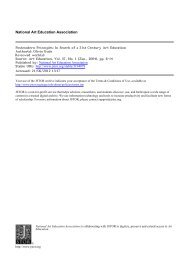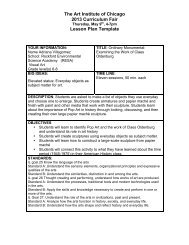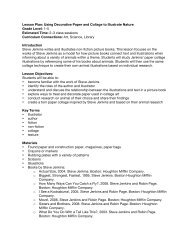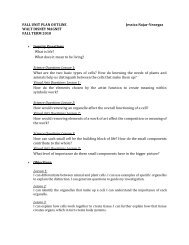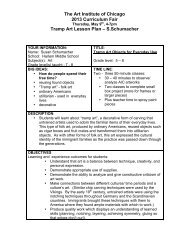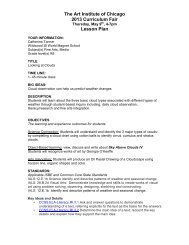Lesson 1 - LearningThroughMuseums
Lesson 1 - LearningThroughMuseums
Lesson 1 - LearningThroughMuseums
You also want an ePaper? Increase the reach of your titles
YUMPU automatically turns print PDFs into web optimized ePapers that Google loves.
• His paintings of life in the Midwest are well known and part of an art movement called Regionalism.<br />
Regionalist painters nostalgically recorded America’s rural areas and small towns, especially<br />
in the Midwest and South, during a time of rapid industrialization and urban growth for the country.<br />
The painters intended their images to be a positive force in an age of economic depression.<br />
• Painted in 1930, the painting shows a man and woman (likely a farmer and his daughter) posed in<br />
front of a farmhouse in rural Iowa. The architectural style of the house is called Carpenter Gothic,<br />
which partially explains the title of the painting. “Gothic” refers to a period in the late Middle Ages<br />
characterized by the use of the pointed arch, as seen in the second story window of the house<br />
behind the couple.<br />
• Although we cannot see the actual farm land, a portion of a red barn and the man’s overalls and<br />
pitchfork suggest that these are farm folk. A church steeple far in the background reminds the<br />
viewer of the religious values of many rural Americans.<br />
• The serious expressions on the faces of the figures suggest they are unhappy, but are more likely<br />
a reference to the common practice of early photographs, which had a long exposure time. It was<br />
very hard to hold a smile for such a long time, so many people didn’t.<br />
• The painting also includes many playful elements and patterns. For example, the rounded trees<br />
match the rounded frames of the man’s glasses, and the brown and white design on the woman’s<br />
apron are similar to that on the window curtain above her. By adding these playful touches, Grant<br />
Wood helps us see that these two people were not as unhappy as their faces might suggest.<br />
You will find additional useful information from the following sources:<br />
Web sites<br />
• The Art Institute of Chicago<br />
Information about American Gothic:<br />
http://www.artic.edu/aic/collections/artwork/6565<br />
http://www.artic.edu/artaccess/AA_Modern/pages/MOD_5.shtml<br />
• Information about The Coffee House:<br />
http://www.artic.edu/aic/collections/artwork/118283<br />
• American Art Collection:<br />
http://www.artic.edu/artaccess/AA_American/index.html<br />
Additional Web sites<br />
• Terra Foundation for American Art: Grant Wood:<br />
http://terraamericanart.org/collections/code/emuseum.asp?XXX_QS_XXX&newvalues=1&rawsea<br />
rch=constituentid/,/is/,/32/,/false/,/true&newstyle=single&newprofile=people&newsearchdesc=Gra<br />
nt%20Wood&newcurrentrecord=1&module=people<br />
• <strong>Lesson</strong> Plan for teaching about the Carl Sandburg poem “Chicago” (1916):<br />
http://edsitement.neh.gov/view_lesson_plan.asp?id=678<br />
* This lesson includes photos to compare and contrast with “The Coffee House.”<br />
• Chicago History Museum Web site:<br />
http://www.chicagohs.org/<br />
66 • <strong>Lesson</strong> 4: The Midwest ‒ The City and the Farm



